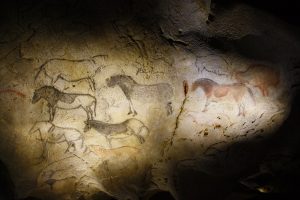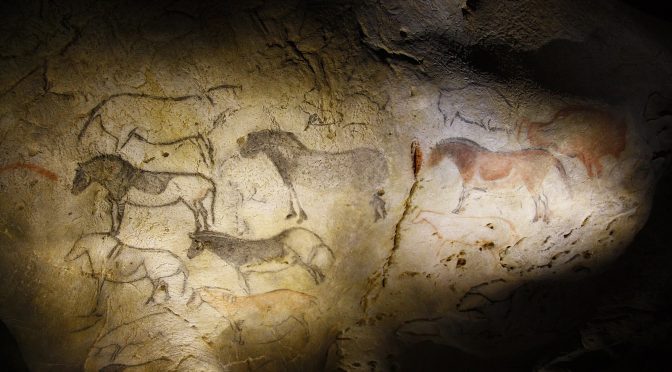Because of the mountainous landscape of the Basque Country, caves play an important role in the historical and mythological context of the culture. The goddess Mari, for example, was said to inhabit various caves in the rugged mountains. But so did people, the ancient people who lived in the Basque Country and left their mark with paintings on the walls of some of those caves. Santimamiñe is perhaps the most famous, but there are many others. One of those is Ekain.

- The Ekain cave, which sits in the mountain of the same name and is part of the jurisdiction of Deba, was discovered on June 8, 1969 by Rafael Rezabal and Andoni Albizuri, members of the Antxieta cultural society. Or rather, it was rediscovered, as clearly humans had found the cave before, albeit millennia before. The cave, burrowing into a limestone cliff, is near the village of Sastarrain where two streams, full of trout, meet.
- The walls of the cave are covered in drawings from the Magdalenian period of the Upper Paleolithic time – roughly 17,000 to 12,000 years ago. The drawings themselves come in many forms. Some are very simple, consisting of just a few strokes, but others are more elaborate. Most are of animals. Different parts of the cave have more of one type of animal than another and thus have been given names to reflect that diversity: Auntzei, “goat shed;” Zaldei, “stable;” Artzei, “bear cabin;” and Azken-zaldei, “last stable.” Of the 70 figures that have been identified, 64 are painted and 6 are engraved into the stone.
- These figures are mostly painted in black, red, or both colors. The black is made with charcoal or manganese and the red comes from limonite, a natural iron oxide mineral.
- There is also an image of a bird, found engraved on the rib bone of what might have been a bison, which is unusual for cave art.
- Archeologists, led by José Miguel Barandiarán, also discovered hearths in the “lobby” of the caves, along with materials likely used by the artists to decorate the harder-to-reach interiors. This suggests that Paleolithic hunters used the cave for shelter. The earlier inhabitants likely used the caves in the summer and consisted on a diet of fawns and hinds. Later ones also hunted mountain goats
- The archeological and historical importance of the cave was recognized in 2008, when it was added to the UNESCO World Heritage list.
- The actual cave is not open to the public, to preserve the art from human traffic. Instead, as has been common practice for such sites, a replica was made, named Ekainberri – or new Ekain. At Ekainberri, not only can one see reproductions of this prehistoric art, but visitors can also partake in other activities that reflect life in the Paleolithic, including making their own cave paintings, making fire with sticks and stones, and hunting with spears.
A full list of all of Buber’s Basque Facts of the Week can be found in the Archive.
Primary sources: Barandiaran Ayerbe, José Miguel de. EKAIN. Auñamendi Encyclopedia, 2024. . Available at: https://aunamendi.eusko-ikaskuntza.eus/en/ekain/ar-37575/; Cueva de Ekain, Wikipedia
Discover more from Buber's Basque Page
Subscribe to get the latest posts sent to your email.


